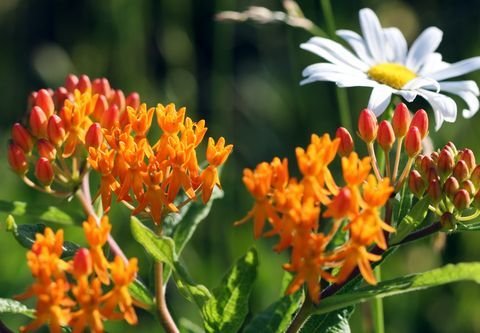Asclepias tuberosa
Popular Milkweed

| Photo: Melinda Fawver |
There are many names for Asclepias tuberosa, which is simply Milkweed. Also called Butterflyweed and Butterfly Milkweed, there are more than 150 known species.
From the Asclepiadaceae, or milkweed family, other names include Pleurisy root, Chigger Flower and Orange Milkweed. With the exception of Orange Milkweed, all Asclepias tuberosa species produce a milky sap that are known to be toxic to humans.
The overview of these showy plants:
- Milkweeds are mid-sized perennial plants that grow anywhere from 1 to 3 feet.
- Plants grow well in drought and low water conditions. Plants do prefer slightly moist, well drained soil types.
- Prefers full sun.
- Can be propagated from seed and root cuttings and wind dispersal with the seedpod traveling in late summer and early fall. Root cuttings should be taken in the fall by cutting the taproot into 2-inch sections and plant each section vertically, keeping the area moist. It can take 2-3 years for the plant to begin thriving.
- Plants become well established and can be divided.
- Grows in planting zones 4-9. This includes most of the United States and Canada.
- Flowers bloom May through September throughout the summer and late summer.
-
Deer resistant.
Asclepias turberosa is very conspicuous offering flower colors of orange, yellow and red. Plants don't work well with formal garden layouts but rather more casual, natural gardens. It can be found in nature growing in prairies, meadows and other open woods, canyons, and some hillsides. See butterfly meadows to understand the difference between these.
Milkweed is a staple plant for any butterfly garden. Not only does it attract butterflies for its rich nectar, it also is a great Hummingbird plant.
- Milkweeds are butterfly host plants for the Gray Hairstreak Butterfly (Strymon melinus) and especially the beloved Monarch (Danaus plexippus) and Queen Butterfly (Danaus gilippus). See butterfly wings and the butterfly migration pages to understand how important this is to these brushfooted butterflies.
- Asclepias tuberosa provides a very rich nectar source for all hungry butterflies.
- Attracts both hummingbirds and hummingbird clearwing moths.
- Other Lepidoptera that are attracted to the butterfly plant include Painted Ladies, American Ladies, Swallowtails, Red Admirals, Hairstreak Butterflies and Fritillaries.

| Photo: Mark Herreid |
Asclepias tuberosa very often gets Aphids.
A natural elimination of aphids is releasing ladybugs. Other options include spraying the plants with soapy water or hosing them with a strong blast of water from the hose.
FYI:
The name Pleurisy Root comes from the fact that the root is chewed on by Indian tribes to cure pleurisy, also known as pleuritis. This is inflammation of the pleurea membranes that surround the lungs. Chewing on this tough root offers relief for various pulmonary issues.
Because the root and milky sap are not edible, chewing in large quantities can be toxic. Symptoms include spasms, vomiting, weakness and mental stupor.
Back from Asclepias tuberosa to Flowers to Attract Butterflies
Back to home page Easy Butterfly Garden
 Copyright © 2010-2022 Easy-Butterfly-Garden.com
Copyright © 2010-2022 Easy-Butterfly-Garden.com
Privacy Policy Disclaimer

Join Easy Butterfly Garden on Facebook
Recent Articles
-
Annual Bluegrass
Jan 14, 17 08:14 PM
Annual bluegrass (Poa annua) is considered a weed in the Poa family, which has a few popular turf grasses. If this gets into your butterfly garden listed are a few ways to eradicate it.
-
Candytuft Flowers
Sep 25, 16 10:54 PM
There are the annual, or Iberis, candytuft flowers and also perennials which are called Iberis sempervirens.
-
Keeping Deer Out
Sep 19, 16 01:10 PM
Reviewing the types of products available for keeping deer out of our gardens along with building fences. Many of these products help with other garden pests.
-
Butterfly Meadows
Sep 19, 16 12:52 PM
Compared to other wildlife gardening, butterfly meadows take time and are not for the faint of heart.
-
Natural Gardening
Sep 19, 16 12:32 PM
Natural gardening includes different types of gardens. These garden types create a casual, natural envirionment and help sustain native wildlife which includes butterflies.






New! Comments
Have your say about what you just read! Leave me a comment in the box below.